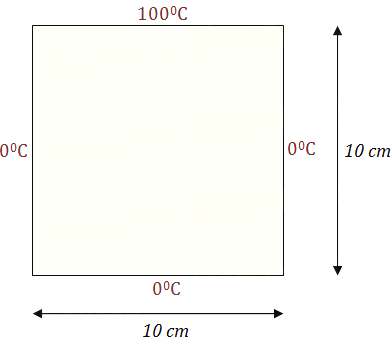|
|
4 years ago | |
|---|---|---|
| .gitignore | 4 years ago | |
| Poisson.ipynb | 4 years ago | |
| Readme.md | 4 years ago | |
| output_6_0.png | 4 years ago | |
| output_8_0.png | 4 years ago | |
| paraview-results.png | 4 years ago | |
| physicalproblem.PNG | 4 years ago | |
| resulteq.png | 4 years ago | |
| solution.pvd | 4 years ago | |
Readme.md
Introduction
The Poisson's equation is a second-order partial differential equation that stats the negative Laplacian $-\Delta u$ of an unknown field $u=u(x)$ is equal to a given function $f=f(x)$ on a domain $\Omega \subset \mathbb{R}^d$, most probably defined by a set of boundary conditions for the solution $u$ on the boundary $\partial \Omega$ of $\Omega$:
$$-\Delta u =f \quad \text{in } \Omega\text{,}$$ $$u=u_0 \quad \text{on } \Gamma_D \subset \partial\Omega \text{,}$$
here the Dirichlet's boundary condition $u=u_0$ signifies a prescribed values for the unknown $u$ on the boundary.
The Poisson's equation is the simplest model for gravity, electromagnetism, heat transfer, among others.
The specific case of $f=0$ and a negative $k$ value, leaves to the Fourier's Law.
Comparative analysis
Along this example, the fenics platfomr is used to compare results obtained by solving the heat equation (Laplace equation) in 2-D:
$$\frac{\partial^2 T}{\partial x^2}+ \frac{\partial^2 T}{\partial y^2}=0$$
the problem is defined by the next geometry considerations:
The resulting contour of temperature, solving using finite diferences, is shown next:
Solving by Finite Element Method with Varational Problem formulation
#1 Loading functions and modules
from fenics import *
import matplotlib.pyplot as plt
#2 Create mesh and define function space
mesh = RectangleMesh(Point(0,0),Point(20,20),10, 10,'left')
V = FunctionSpace(mesh, 'Lagrange', 1) #Lagrange are triangular elements
plot(mesh)
plt.show()
#3 Defining boundary conditions (Dirichlet)
tol = 1E-14 # tolerance for coordinate comparisons
#at y=20
def Dirichlet_boundary1(x, on_boundary):
return on_boundary and abs(x[1] - 20) < tol
#at y=0
def Dirichlet_boundary0(x, on_boundary):
return on_boundary and abs(x[1] - 0) < tol
#at x=0
def Dirichlet_boundarx0(x, on_boundary):
return on_boundary and abs(x[0] - 0) < tol
#at x=20
def Dirichlet_boundarx1(x, on_boundary):
return on_boundary and abs(x[0] - 20) < tol
bc0 = DirichletBC(V, Constant(0), Dirichlet_boundary0)
bc1 = DirichletBC(V, Constant(100), Dirichlet_boundary1) #100C
bc2 = DirichletBC(V, Constant(0), Dirichlet_boundarx0)
bc3 = DirichletBC(V, Constant(0), Dirichlet_boundarx1)
bcs = [bc0,bc1, bc2,bc3]
#4 Defining variational problem and its solution
k =1
u = TrialFunction(V)
v = TestFunction(V)
f = Constant(0)
a = dot(k*grad(u), grad(v))*dx
L = f*v*dx
# Compute solution
u = Function(V)
solve(a == L, u, bcs)
# Plot solution and mesh
plot(u)
plot(mesh)
# Save solution to file in VTK format
vtkfile = File('solution.pvd')
vtkfile << u





